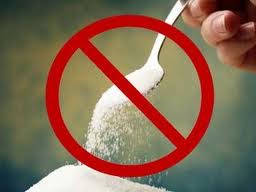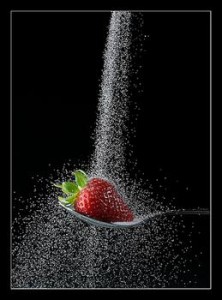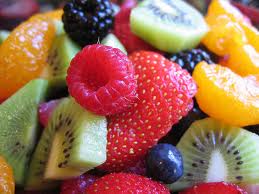While I’m clearly not in favor of ove r-consumption of sugar, I have to admit I’m growing a bit tired of all the hype about the evils of sugar. It’s becoming a target for journalists and medical professionals alike… most of whom don’t seem to be clearly considering the bigger picture, and are often misinterpreting the research that exists and/or taking it out of context. I’ve decided to begin a series or articles to shed some light on some of the hype, over-exaggerations, fallacies and truths surrounding the recent “sugar is evil” trend. My intent is not to indiscriminately defend the consumption of sugar nor do I recommend recklessly including abundant amounts of sugar in your daily diet. However, I do hope to help separate fact from fiction and help people understand where science ends and opinions based on fear and extrapolation begin.
r-consumption of sugar, I have to admit I’m growing a bit tired of all the hype about the evils of sugar. It’s becoming a target for journalists and medical professionals alike… most of whom don’t seem to be clearly considering the bigger picture, and are often misinterpreting the research that exists and/or taking it out of context. I’ve decided to begin a series or articles to shed some light on some of the hype, over-exaggerations, fallacies and truths surrounding the recent “sugar is evil” trend. My intent is not to indiscriminately defend the consumption of sugar nor do I recommend recklessly including abundant amounts of sugar in your daily diet. However, I do hope to help separate fact from fiction and help people understand where science ends and opinions based on fear and extrapolation begin.
Lest anyone accuse me of having ties to sugar or processed food industries, it is probably worth stating that my graduate research (in the early 1990’s) was sponsored in part by the Sugar Institute, but did not produce outcomes favorable to their marketing efforts. In fact, my research, which involved the effect of diet on insulin secretion, suggested that a high sugar diet is an unhealthy choice… and I published my results stating just that. I’m interested in facts – not marketing or hype – just facts interpreted correctly. So let’s get started looking at some of the current claims about sugar which are circulating in the popular press and on social networks. What is true and what is questionable?
A recent article published in the Huffington Post on April 10, 2012 has this sensationalized title “Sugar In Food: 8 Eats With More Than A Twinkie.” This article is a great example of how information is taken out of context and extrapolated to fit the author’s agenda. It contains a few accurate facts and a lot of what I like to call half-truths or statements that are “half a bubble off.” One of the central statements of this article is this:
In 2009, the American Heart Association recommended that women eat or drink no more than 20 grams of sugar a day, and men no more than 36 grams. That means one Snickers bar, at 30 grams of sugar, would be about all the sugar the average man should eat in an entire day. For women, that equivalent to about one Twinkie, which will set you back 18 grams.
In truth, what the statement on the website for the American Heart Association actually said:
“The American Heart Association (AHA) recommends limiting the amount of added sugars you consume to no more than half of your daily discretionary calories allowance. For most American women, that’s no more than 100 calories per day, or about 6 teaspoons of sugar. For men, it’s 150 calories per day, or about 9 teaspoons. The AHA recommendations focus on all added sugars, without singling out any particular types such as high-fructose corn syrup. For more detailed information and guidance on sugar intake limits, see the scientific statement in the August 2009 issue of Circulation, Journal of the American Heart Association.”
To take this statement in context we must first define what discretionary calories are. The USDA defines these as “the difference between total energy requirements and the energy consumed to meet recommended nutrient intakes.” Their statement then goes on to explain
“Because of sedentary lifestyles and food choices that frequently are relatively high in added sugars and solid fats, most Americans have used up discretionary calories even before meeting recommendations for nutrient intakes. The maximum amount of discretionary calories is based on the difference between their total daily calorie requirement and the number of calories used to meet nutrient recommendations.
Discretionary calories can be available only when the amount of calories used to meet recommended nutrient intakes is less than the total daily calorie expenditure. The magnitude of this difference, and whether it is positive or negative, depends on two factors: (1) the nutrient content of the foods consumed, and (2) the total energy requirement, which, in turn, is greatly dependent on the level of physical activity.”
So what exactly does that mean? In a sense it is suggesting that sedentary Americans are often under-nourished but over-fed.  Discretionary calories are essentially the “extra” calories that we can spend however we want once our nutritional needs have been met by the rest of the food that we eat each day. It’s kind of like having a little spending money left after all the bills have been paid. Right away there are a few things to point out. First, not everyone in America is sedentary. Those who are physically active often have more “discretionary calories” to spend each day because their total daily energy (calorie) need is higher than it is for sedentary individuals. Second, people who eat a lot of nutrient dense food (fruits, vegetables, whole grains, lean protein) can get their nutrient requirements met without spending a lot of calories, so will have more “discretionary calories” that they can afford to spend on other things without usurping necessary nutrients. Third, perhaps the focus is too much on what NOT to include (i.e. empty calories such as sugar) and not enough on what TO include (nutrient-rich whole foods). I find that when I am able to successfully guide people to include more nutrient-dense whole foods in their diets, the less nutritious food tends to fall out on it’s own. In other words, I believe it does more good to cheer for fruits and veggies than it does to boo sugar and fat.
Discretionary calories are essentially the “extra” calories that we can spend however we want once our nutritional needs have been met by the rest of the food that we eat each day. It’s kind of like having a little spending money left after all the bills have been paid. Right away there are a few things to point out. First, not everyone in America is sedentary. Those who are physically active often have more “discretionary calories” to spend each day because their total daily energy (calorie) need is higher than it is for sedentary individuals. Second, people who eat a lot of nutrient dense food (fruits, vegetables, whole grains, lean protein) can get their nutrient requirements met without spending a lot of calories, so will have more “discretionary calories” that they can afford to spend on other things without usurping necessary nutrients. Third, perhaps the focus is too much on what NOT to include (i.e. empty calories such as sugar) and not enough on what TO include (nutrient-rich whole foods). I find that when I am able to successfully guide people to include more nutrient-dense whole foods in their diets, the less nutritious food tends to fall out on it’s own. In other words, I believe it does more good to cheer for fruits and veggies than it does to boo sugar and fat.
Another important distinction made by the AHA that the Huffington Post article does not acknowledge is that the AHA is referring to ADDED SUGARS. This is relevant because these are the discretionary (extra) calories referred to above. Sugars that occur naturally in foods are generally part of nutrient-dense foods so are part of a healthy package that nature has assembled and which our bodies can include as part of a healthy diet. For instance, dairy products and fruits all have some naturally occurring sugars that come as part of a package that includes vitamins, minerals and (in fruits and veggies) fiber. A 6 oz. serving of plain yogurt contains about 12 gm of naturally occurring lactose (milk sugar). So if a container of sweetened yogurt contains 25 gm of sugar, only 13 of those are ADDED SUGAR. Like wise 1 cup of tomato sauce with no added sugar contain 8 gm of naturally occurring sugar from the tomatoes. I am still going to advocate that you purchase a variety without added sugar (or make your own), but I want to emphasize that simply looking at “sugar” content on food labels doesn’t tell the whole story. Below is a chart sumarizing the foods mentioned in the Huffington Post article as being surprisingly high in sugar. Take a look at what taking a closer look at the facts reveals about the accuracy of the accusations. I’ve included facts about total sugar, added sugar, and serving sizes; and my own commentaries about each food item. Also keep in mind that the more exercise you do, the more you can afford to include a bit of added sugar to your diet – especially if you eat a lot of whole , nutrient-rich foods as the main part of your diet. Too much sugar is not good – neither is too much hype. Be sensible and be wise and keep your eye on the big picture.
wise 1 cup of tomato sauce with no added sugar contain 8 gm of naturally occurring sugar from the tomatoes. I am still going to advocate that you purchase a variety without added sugar (or make your own), but I want to emphasize that simply looking at “sugar” content on food labels doesn’t tell the whole story. Below is a chart sumarizing the foods mentioned in the Huffington Post article as being surprisingly high in sugar. Take a look at what taking a closer look at the facts reveals about the accuracy of the accusations. I’ve included facts about total sugar, added sugar, and serving sizes; and my own commentaries about each food item. Also keep in mind that the more exercise you do, the more you can afford to include a bit of added sugar to your diet – especially if you eat a lot of whole , nutrient-rich foods as the main part of your diet. Too much sugar is not good – neither is too much hype. Be sensible and be wise and keep your eye on the big picture.
|
Food item Serving size |
Sugar content per Huffington Post |
Naturally Occurring Sugar Added Sugar |
Comments |
|
|
Yogurt 8 oz |
31 to 32 gm |
16 gm |
Only about 1/2 the sugar is added, the rest is naturally occurring milk sugar. The article mentions a 6 oz serving but then gives sugar info for an 8 oz serving. A 6 oz serving would contain about 12 gm added sugar. | |
|
Tomato Sauce 1/2 Cup |
8 to 12 gm | 4 gm 4 to 8 gm | Choose a sauce with little or no added sugar, or make your own by adding herbs & spices. The amounts of added sugar listed here are not enough to stress over. | |
|
Granola Bar |
11 to 22 gm |
These vary a LOT. Some are pretty much glorified candybars, others are comprised of whole grains and dried fruits (which have naturally occurring sugars) and are very nutrient dense. Choose wisely and stay within your calorie needs. | ||
|
Salad Dressing 1 Cup |
20 to 43 gm |
Seriously, who uses an entire cup of dressing?! The values reported are for 1 cup! Using 2 Tbsp. would whittle these values down to 2.5 to 5.3 gm. sugar per serving, which is not that big of a deal. |
||
|
muffin |
16 to 32 gm |
No defense here; these are just small cakes and are really more of a dessert. Put them in the same category as cup cakes, pancakes and waffles, and enjoy them on special occasions but not every day. | ||
|
canned peaches 1 Cup |
33 gm. |
20 gm. 13 gm |
Most of the added sugar is in the syrup. Drain and rinse canned fruit, and added sugar will be minimal. Better yet, buy fresh or unsweetened frozen fruit. | |
|
smoothie |
38 to 100 gm |
varies |
Avoid smoothies with added sugar; there’s no excuse for adding sugar to fruit juice. The most important concern with smoothies is the portion size. They are often nutrient dense and packed with healthy ingredients, but anything over 6 to 8 oz. is usually more calories than most people need. Smoothies can be a great choice, just watch the portion size. | |
|
Kellogg’s Honey Smacks cereal 3/4 Cup |
20 gm. |
0 gm 20 gm |
I can’t defend this product. It’s just a dessert fortified with vitamins and minerals and disguised as a breakfast cereal. About the only positive I can give is that it’s low in fat. Have a piece of fruit instead. |


Well stated Sally! Great job!
You ROCK Sally. Well said!
Well said! I really hope the day comes when food labels distinguish between natural and added sugars. Til then, we have our work cut out for us!
Love it! Active people are freaking out about sugar…it is CRAZY!
Great post. I’m so glad you explained to people the difference between naturally occuring sugar and added sugar in packaged food. As Janel said above, i really hope that food labels will be changed to separate out added sugar. Would be such a service to consumers.
I’d love to use this idea as a guest post on our blog at wellfedheart.com. It’s a refreshing way to look at sugar usage.
Feel free to contact me.